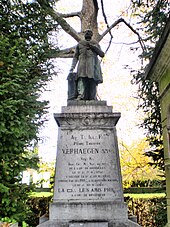|
Saint Verhaegen
Saint Verhaegen (French: Saint-Verhaegen; Dutch: Sint-Verhaegen), commonly shortened to St V, is a holiday for freethinking university students in Brussels, Belgium. It takes place annually on 20 November and commemorates the founding of the Free University of Brussels on 20 November 1834. The day's name is a reference to Pierre-Théodore Verhaegen, the university's founder, who notably is not a saint and was never canonized; the name was chosen instead to mock the Saint Nicholas festivities of the rival Catholic University. The festivities started in 1888 as a protest against the then-academic authorities and has since grown into an annual parade that pays tribute to Verhaegen and the values of free inquiry. Nowadays, the event is organised by the Brussels Student Association and is celebrated by students of both the Université libre de Bruxelles (ULB) and the Vrije Universiteit Brussel (VUB), which officially separated in 1970. OriginsThe event dates back to 24 November 1888, when students of the university organised to protest a university reorganisation that was perceived as undemocratic and against the principle of free inquiry (French: libre examen, Dutch: vrij onderzoek), on which the university was founded. That morning, 200 of the university's 1,400 students, with many freemasons (as Verhaegen was also the founder of the Grand Orient of Belgium), assembled and left a wreath of oak leaves on Verhaegen's tomb.  In following years, the students, with much fanfare and waving the flags of their respective student organisations, would form a long procession to pay homage to Verhaegen at his tomb and a monument in his honour. These celebrations continue to this day, although the students are now generally more concerned with drinking in the streets; the honouring of Verhaegen is done largely by faculty and leaders of the student organisations and is more formal and official. In the last few years, a revival of the formalities has occurred due to several restrictions imposed by the city council.[1] Students get the day off for the events; no classes are scheduled that day.[2] Celebrations Most student groups rent a large transport truck for the occasion, which they decorate in accordance with the year's theme. Each truck has a large number of kegs inside, and some students are designated to serve beer to the others all day, with an all-you-can-drink payment scheme. Many also bring large sound systems which play loud music all day. 2013's Saint Verhaegen saw 6,000 students and 27 transport trucks take part in the procession.[3] The students first meet at the Square du Grand Sablon/Grote Zavelsquare in central Brussels, and after several hours, the trucks start to move towards the former Brussels Stock Exchange on the Boulevard Anspach/Anspachlaan (Brussels' main boulevard). This takes several hours as well, as the trucks move only at a walking speed and are more often than not stopped due to the students surrounding them and on the road. Beer may not be served while the trucks are in motion. All roads which the procession goes on are closed to other traffic, including the Boulevard Anspach. The students then disperse and reconvene around 9 p.m. at ULB's Solbosch campus, where all the year's decorations are burnt semi-ceremonially.[4] Many alumni come to the university's discothèque on that night, which is normally only open to current students. After the November 2015 Paris attacks, the city council decided to cancel the event for the first time since World War II.[5] A large part of the students, however, ignored that ban and proceeded to occupy the traditional starting point of the Square du Grand Sablon only to later continue with the procession on foot.[6] The following year, the city council forbade the use of the transport trucks and limited the consumption of alcohol to the start- and end-points; the students responded by throwing flour at each other and passers-bys. The origins of the flour-throwing dates back to a past tradition of the holiday where the students used to throw eggs, flour and water at the local catholic bourgeoisie who lived in and near the Square du Grand Sablon, after they had repeatedly pleaded with to city council to try and stop the event from happening because they disapproved of the students using the square as their starting point.[7] In 2019, Saint Verhaegen was included in the inventory of intangible cultural heritage of the Brussels-Capital Region.[8][9][10] Yearly themes and medalsSince 1931, Saint Verhaegen has been given a yearly theme, usually responding to current events and taking a liberal/anti-clerical approach. However, political themes are not shunned either, with students often using Saint Verhaegen to raise awareness on social problems, ideological issues and humanitarian crises. Fascism, the School Struggle, state reforms, community fault lines, language politics, abortion, apartheid, human rights, freedom of speech, nationalism, migration, terrorism, climate change, poverty, the far-right, etc., among others, have already formed the theme of the celebration. In practice, the annual theme often emerges in the decorations of the floats, the party stands on the Sablon and is expressed on banners and signs.[clarification needed] Since 1938, the organisation has also issued an official medal every year, which features an often explicit illustration. Initially this was done by the Association Générale des Etudiants (AGE), later the ACE and the BSG took on this task.[11] A competition is usually held for the design of the medals, in which VUB and ULB students are allowed to submit their designs. Associations and individuals also regularly issue medals on their own initiative at Saint Verhaegen that are separate from the official theme. Given their long tradition and limited circulation, the medals have become coveted collector's items among some, such as in 1988, for the event's 100th anniversary. Overview of the annual themes since 1931
See alsoReferences
External links
|
||||||||||||||||||||||||||||||||||||||||||||||||||||||||||||||||||||||||||||||||||||||||||||||||||||||||||||||||||||||||||||||||||||||||||||||||||||||||||||||||||||||||||||||||||||||||||||||||||||||||||||||||||||||||||||||||||||||||||||||||||||||||||||||||||||||||||||||||||||||||||||||||||||||||||||||||||||||||||||||||||||||||||||||||||||||||||||||||||||||















